-
Hamilton, Glendenning, Thomas (T.G.) (1873, Toronto–1935, Winnipeg, Manitoba) and Lillian May Hamilton (1880, Belleville–1956, Winnipeg)
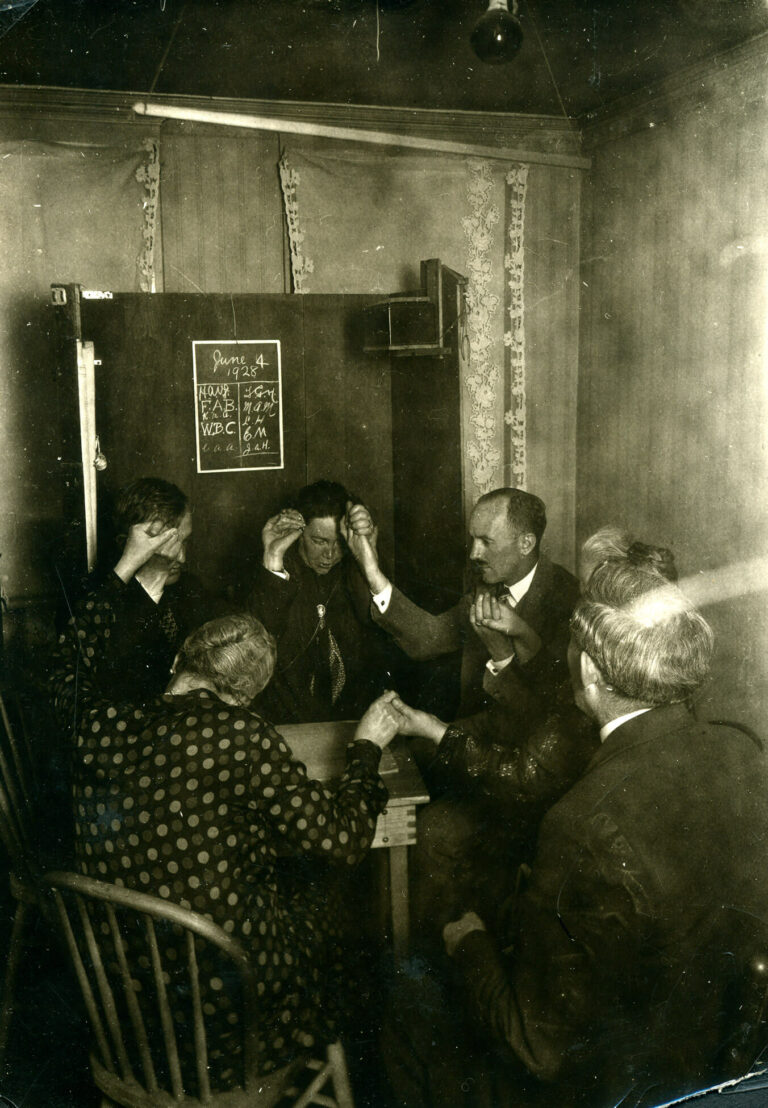
T.G. Hamilton was a medical doctor who, along with his wife Lillian, is known for using photography in psychical research. The pair became interested in paranormal phenomena after the death of one of their children in 1919. They held séances in their home, and T.G. photographed aspects of their spiritualist investigations, including telekinesis, teleplasm, trance states, and various other psychic phenomena. Lillian compiled and annotated albums describing the events in the photographs. This example features a photograph of a séance during which bell cords were rung, indicating the presence of a spirit. Following T.G.’s death in 1935, Lillian continued to hold séances, and in the 1940s she and her daughter Margaret and son James wrote about the family’s investigations. The Hamilton Family Fonds are held at the University of Manitoba Archives and Special Collections.
Image: Thomas Glendenning Hamilton and Lillian Hamilton, First Bell Cords (annotated photo album #2), June 4, 1928, University of Manitoba Archives, Winnipeg.
For further reading, see:
Oates, Katie. “Women, Spirit Photography, and Psychical Research: Negotiating Gender Conventions and Loss.” PhD diss., Western University, 2022.

-
Hammond, Melvin Ormand (1876, Clarkson, Ontario–1934, Toronto)
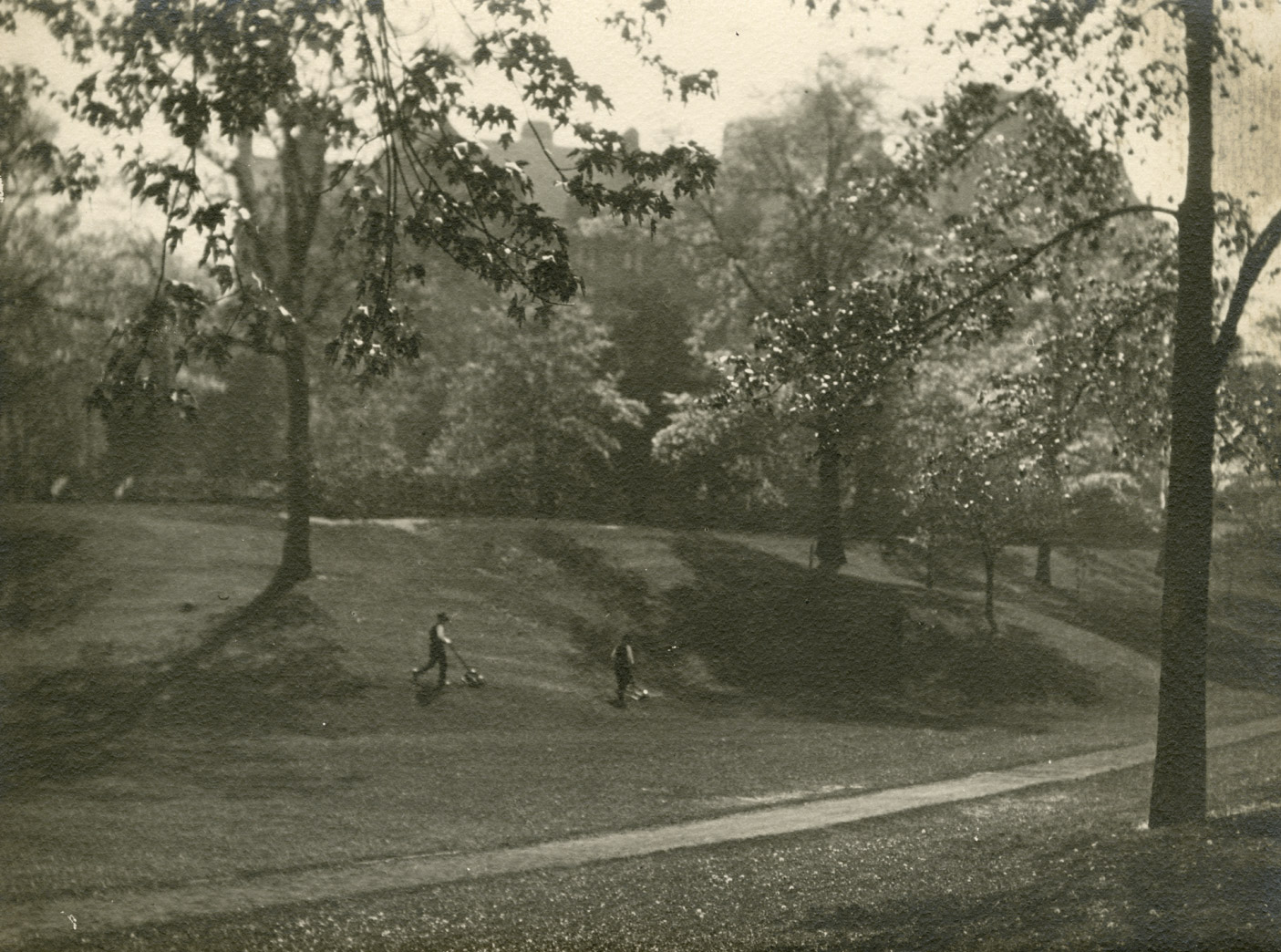
M.O. Hammond became a reporter for the Globe (now the Globe and Mail) in 1895, at the age of twenty, and began taking photographs to illustrate his stories. He later became the paper’s literary editor and editor of the Saturday magazine section. Hammond was an active member of the Toronto Camera Club (1906), where he later served as president, and explored the artistic potential of photography by experimenting with Pictorialism. He is best known for his photographs of noted figures in the arts and literary scene in Toronto, as well as his images of the changing cityscape.
Image: Melvin Ormand Hammond, Lawn Maintenance at Toronto Island, c.1910–30, silver gelatin print on textured semi-matte paper, 29.4 x 22.4 cm, Archives of Ontario, Toronto.
For further reading, see:
Archives of Ontario. “Hammond, M.O. (Melvin Ormond), 1876–1934.” Biographical sketch (fonds 1075). AIMS (Archives and Information Management System). 1888–1983. aims.archives.gov.on.ca/SCRIPTS/MWIMAIN.DLL/218446256/1/3/847?RECORD&UNION=Y.
Sutnik, Maia-Mari, et al. Photographs by Charles Macnamara and M.O. Hammond: Pictorial Expressions in Landscape and Portrait. Toronto: Art Gallery of Ontario, 1989.

-
Hannon, Gerald (1944, Bathurst, New Brunswick–2022, Toronto)
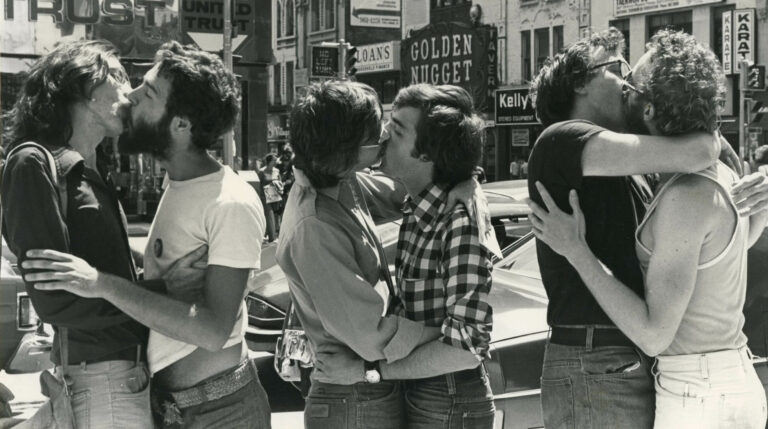
Hannon was a journalist and photographer who became a spokesperson for Toronto’s LGBT community in the 1970s and 1980s. His photographs document the people and protests of gay liberation and humanize a community that was stigmatized and targeted by law enforcement. His work was published in the Toronto LGBT magazine The Body Politic (1971–87).
Image: Gerald Hannon, Kiss-in at the corner of Yonge and Bloor, Toronto, 1976, gelatin silver print, The ArQuives, Toronto.
For further reading, see:
Hackett, Sophie. “What It Means to Be Seen: Photography and Queer Visibility.” What It Means to Be Seen: Photography and Queer Visibility / Zanele Muholi: Faces and Phases. Toronto: Ryerson Image Centre, 2014, 8–25. Exhibition catalogue.
Jackson, Ed, and Stan Persky, eds. Flaunting It! A Decade of Gay Journalism from The Body Politic. Toronto and Vancouver: Pink Triangle Press and New Star Books, 1982.

-
Harris, Pamela (b.1940, Erie, Pennsylvania)
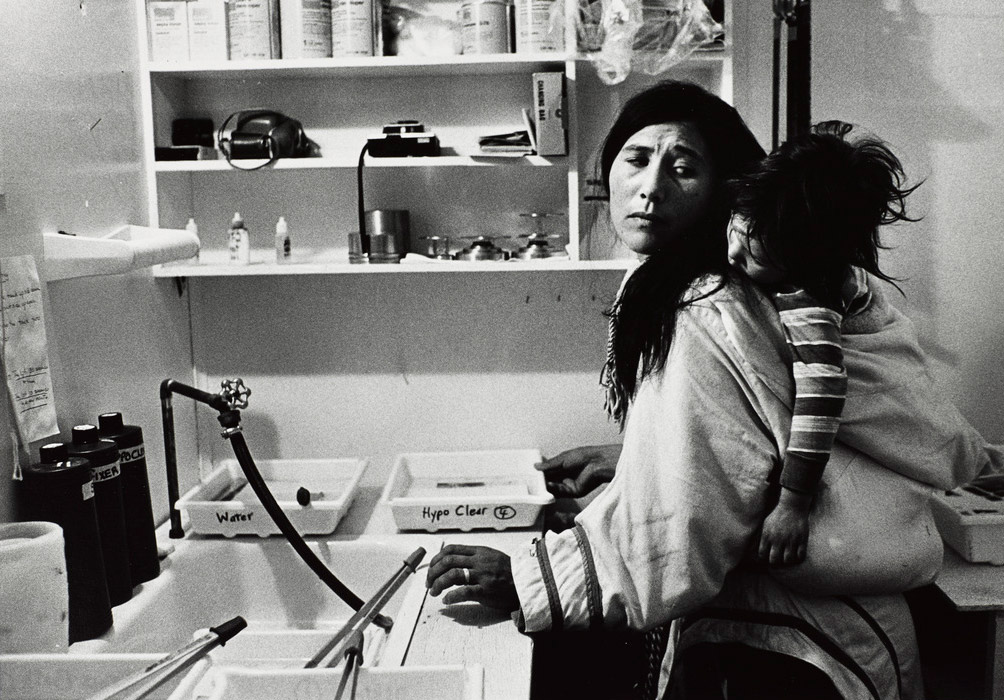
Harris was born in the U.S. and came to Canada in 1967. She is a self-taught documentary photographer with a focus on community, and her major projects include Newfoundland fishing villages, an Arctic hamlet, Taloyoak (formerly Spence Bay), farm workers, nannies, grassroots feminists across Canada, and her extended family. With others, she produced The Women’s Kit at the Ontario Institute for Studies in Education (OISE) and the first exhibit in Canada of photographs of women by women. In 1972–73, while photographing in Taloyoak, Nunavut, she established a community darkroom and taught darkroom skills to Inuit craftswomen who used it to document their work.
Image: Pamela Harris, Niloulaq and Willie in the darkroom, 1973, gelatin silver print, 20.3 x 25.4 cm, Art Gallery of Ontario, Toronto.
For further reading, see:
Hackett, Sophie, Gaëlle Morel, and students from the Toronto Metropolitan University School of Image Arts, Film and Photography Preservation and Collections Management Graduate Program. “The Darkroom Project: Taloyoak, 1972–1973.” The Image Centre, 2017. theimagecentre.ca/exhibition/the-darkroom-project-taloyoak-19721973/.
Harris, Pamela. Another Way of Being: Photographs of Spence Bay N.W.T. Toronto: Impressions, 1976.
Harris, Pamela. Faces of Feminism: Portraits of Women Across Canada. Toronto: Second Story Press, 1992.
Women’s Photo Co-op, ed. Image Nation Eleven: Photographs by Women about Women. Toronto: Coach House Press, 1971.

-
Hassan, Jamelie (b.1948, London, Ontario)
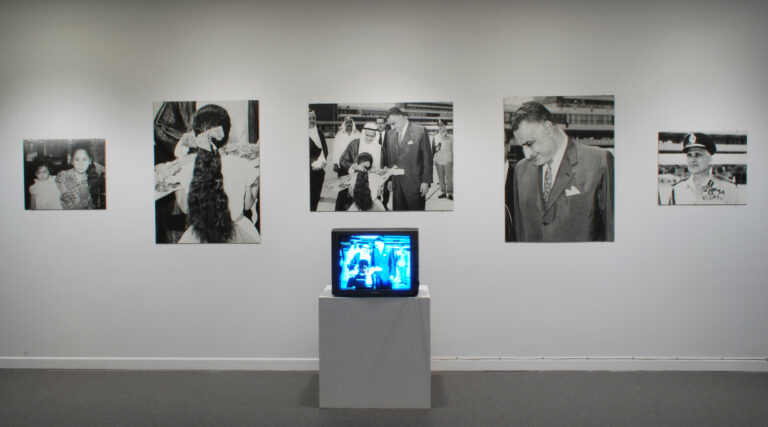
Hassan is a contemporary artist, curator, and activist based in London, Ontario. She works in a range of media and has incorporated photography as an important aspect of her installation-based practice since the mid-1980s. Hassan’s work explores themes of colonialism and conflict through the intersections of personal and political history. She received a Governor General’s Award in Visual and Media Arts in 2001.
Image: Jamelie Hassan, Meeting Nasser, 1985, five black and white photographs mounted on Masonite, three VCR videotapes, and two laminated sheets, dimensions variable, Art Gallery of Nova Scotia, Halifax.
For further reading, see:
Gagnon, Monika Kin. “Al Fannanah ‘I Rassamah: Jamelie Hassan.” SightLines: Reading Contemporary Canadian Art, edited by Jessica Bradley and Lesley Johnstone, 402–412. Montreal: Artexte Information Centre, 1994.
Townsend, Melanie, and Scott Watson. Jamelie Hassan: At The Far Edge of Words. London and Vancouver: Museum London and the Morris and Helen Belkin Art Gallery, 2009.

-
Heath, Dave (1931 Philadelphia–2016, Toronto)
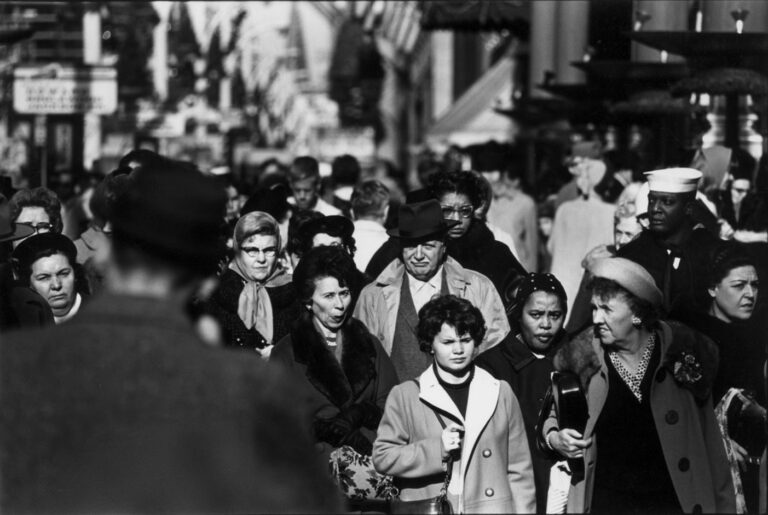
Heath lived and worked in Philadelphia, Chicago, and New York before moving to Toronto in 1970 for a teaching position at Ryerson Polytechnical Institute (now Toronto Metropolitan University). Heath’s work is concerned with psychological experience and the human condition. His acclaimed book A Dialogue with Solitude (1965) is a poetic meditation in the tradition of photographers of everyday life, such as Robert Frank. Heath was awarded Guggenheim Fellowships in 1963 and 1964, and explored new aesthetic possibilities in street photography. In his late career, Heath worked in colour, first with slides and Polaroid, and then with digital photography.
Image: Dave Heath, Chicago, December 1965, printed 1966, gelatin silver print, image: 11.6 x 17.9 cm, sheet: 12.5 x 20.3 cm, Nelson-Atkins Museum of Art, Kansas City.
For further reading, see:
Davis, Keith. “Dave Heath: In Search of Self.” In Multitude, Solitude: The Photographs of Dave Heath, 12–69. New Haven: The Nelson-Atkins Museum of Art and Yale University Press, 2015.

-
Hime, Humphrey Lloyd (1833, Moy, Ireland–1903, Toronto)
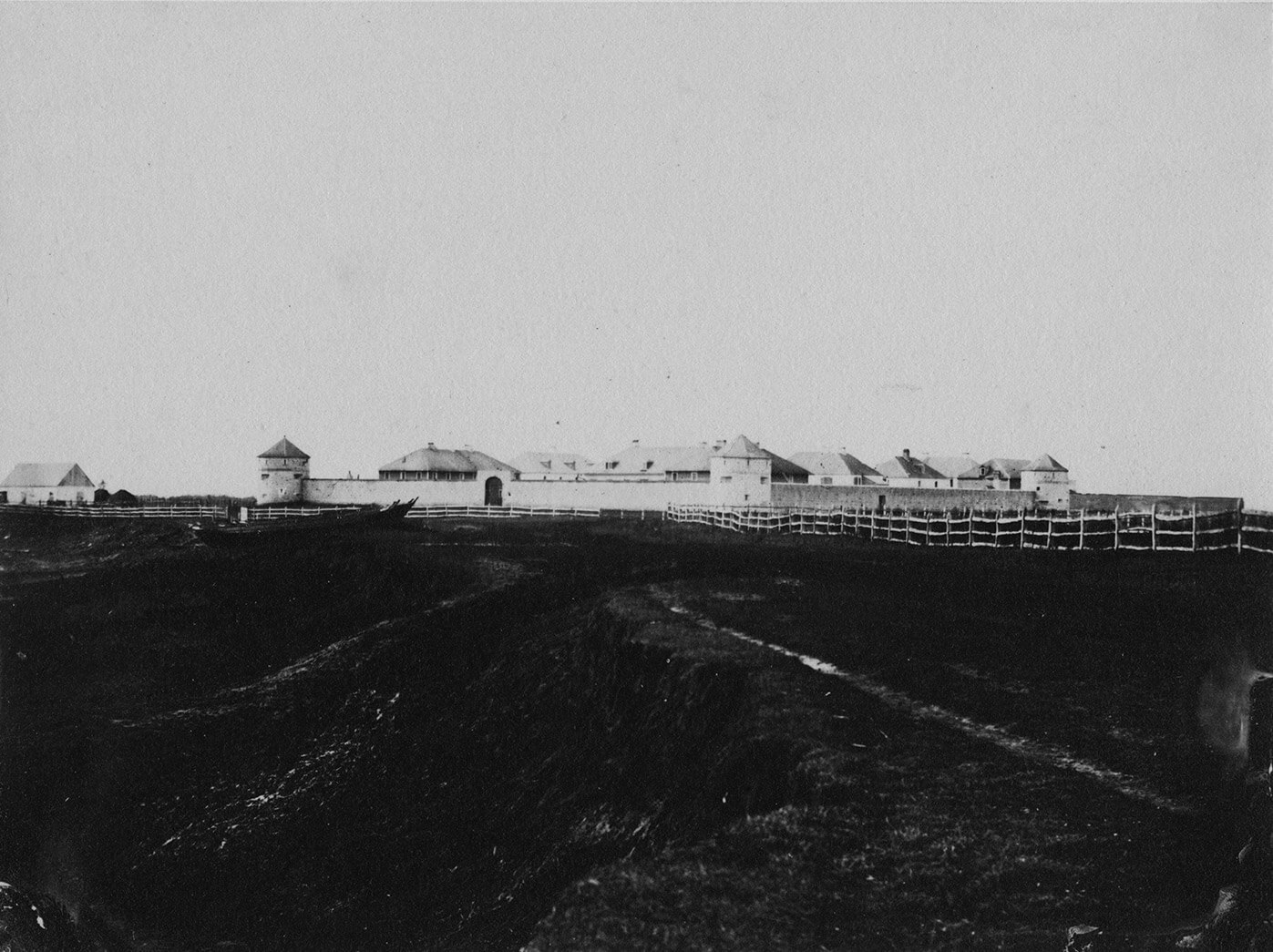
Hime was the photographer for the Assiniboine and Saskatchewan Exploring Expedition (1858) led by Henry Youle Hind. Using the collodion wet plate process, Hime photographed the topography and settlements of the region, including settler and Indigenous dwellings and portraits of inhabitants. Hind used Hime’s photographs to illustrate the expedition reports and press coverage. He also published a portfolio of prints to supplement his narrative account of the expedition. From 1857 to 1861, Hime was a junior partner in the Toronto-based engineering and photography firm Armstrong, Beere & Hime.
Image: Humphrey Lloyd Hime, Fort and stores of the Honourable Hudson’s Bay Company, Fort Garry at the confluence of Red River and the Assiniboine, 1858, albumen print, image: 13 x 17.5 cm; on mount: 27.2 x 36.7 cm, Library and Archives Canada, Ottawa.
For further reading, see:
Huyda, Richard J. Camera in the Interior, 1858: H. L. Hime, Photographer: The Assiniboine and Saskatchewan Exploring Expedition. Toronto: Coach House Press, 1975.
Mattison, Dave. “Humphrey Hime.” Encyclopedia of Nineteenth-Century Photography, Vol. 1, edited by John Hannavy, 664. New York: Routledge, 2008.

-
Holloway, Elizabeth (Elsie) (1882, St. John’s, Newfoundland–1971, St. John’s, Newfoundland)
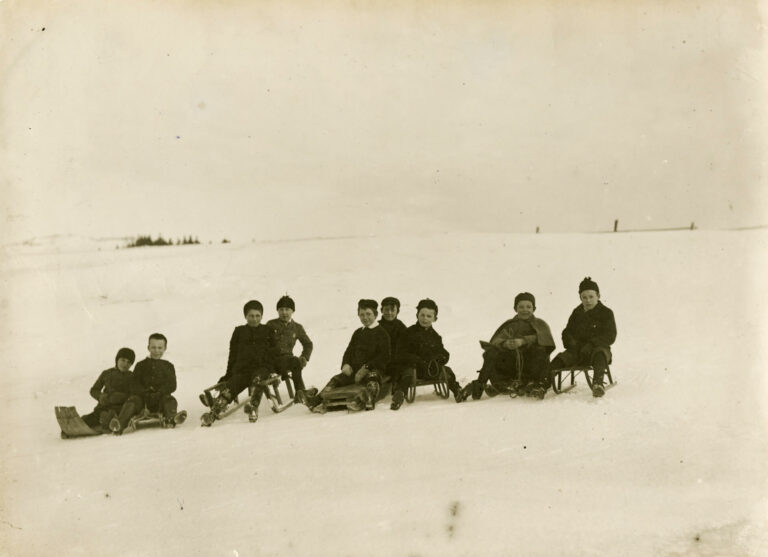
Holloway first learned photography from her father, Robert, head of Methodist College, and then in 1901 studied photography in London. After his death, Elsie and her brother published a book of his work, Through Newfoundland with the Camera (1905), to great success, enabling them to open the Holloway Studio of St. John’s in 1908. The studio offered portrait services and prints from Robert’s negatives as well as an increasing stock of their own views made during travels around the region. After her brother’s death during the First World War, Elsie ran the studio on her own, employing up to a dozen staff at a time, before selling it in 1946. In addition to her natural and lively portraits of children, she also photographed landscapes and major local events, including the departure of Amelia Earhart from Harbour Grace, leaving a crucial visual record of Newfoundland history.
Image: Elizabeth (Elsie) Holloway Studio, Start of the Slide Race, c.1910, black and white photo print, 20.5 x 15 cm, The Rooms Provincial Archives, St. John’s.
For further reading, see:
Higgins, Jenny. “With the Camera: The Life of Elsie Holloway.” Newfoundland and Labrador Heritage, video, 15 min., 2017. www.heritage.nf.ca/videos/elsie-holloway.php.
Jones, Laura. Rediscovery: Canadian Women Photographers 1841–1941. London: London Regional Art Gallery, 1983.
McGrath, Antonia. Newfoundland Photography, 1849–1949. St. John’s: Breakwater Books, 1980.

-
Horetzky, Charles George (1838, Edinburgh–1900, Toronto)
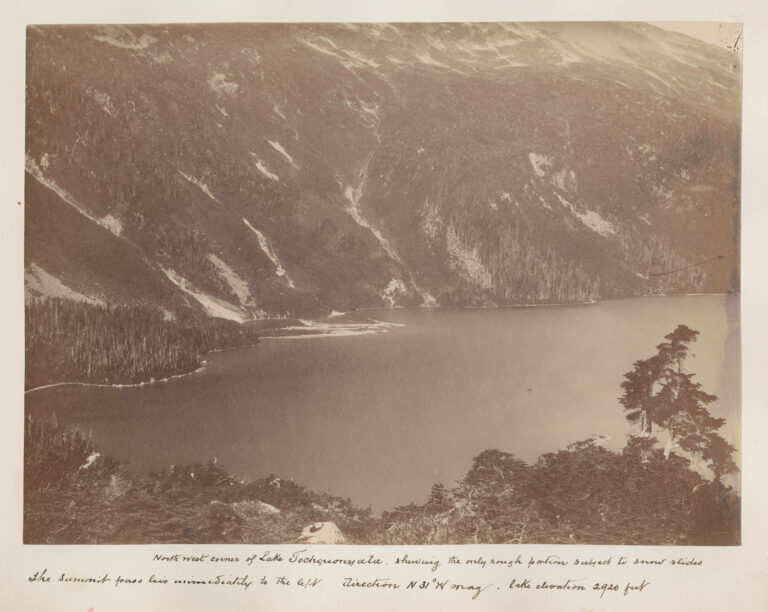
Horetzky was born in Scotland of Ukrainian descent. He is thought to have learned photography while working for the Hudson’s Bay Company at Fort William, on the Ottawa River, and Moose Factory, on James Bay, between 1858 and 1869. He was hired by Canadian Pacific to survey possible routes for the railway and is best known for photographs showing the topography and settlements of western Canada made between 1871 and 1874. He was the first survey photographer to use the dry plate process, which enabled him to work in sub-zero temperatures. Horetzky’s photographs were published in George Grant’s Ocean to Ocean (1877) and with his own writing in Canada on the Pacific (1874) and Some Startling Facts Relating to the Canadian Pacific Railway and the North-West Lands (1880).
Image: Charles Horetzky, Canadian Pacific Railway Survey. Northwest corner of Lake Tochquonyata showing the only rough portion subject to snow slides, British Columbia, 1874, salted paper print mounted on album page, 15.2 x 20.9 cm, Library and Archives Canada, Ottawa.
For further reading, see:
Rodger, Andrew. “Charles George Horetzky.” In Encyclopedia of Nineteenth-Century Photography, Vol. 1, edited by John Hannavy, 714. New York: Routledge, 2008.
Silversides, Brock. Looking West: Photographing the Canadian Prairies, 1858–1957, 5–6. Calgary: Fifth House, 1999.

-
Hunt, George (1854, Fort Rupert, British Columbia–1933, Fort Rupert, British Columbia)
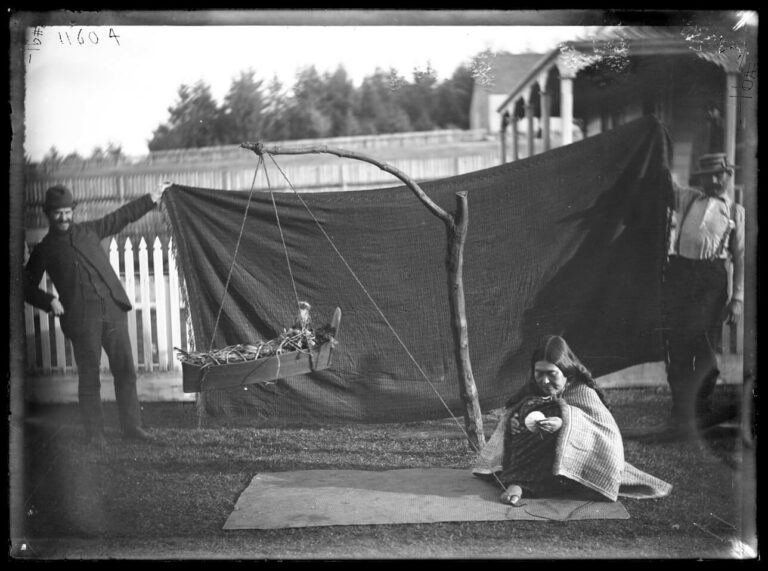
The son of an English fur trader and a Tlingit woman, Hunt (also named Xawe, ’Maxwalagalis, K’ixitasu, and Nołq’ołala) is one of the earliest known Indigenous photographers. He is recognized for working with anthropologist Franz Boas, serving as guide, interpreter, and collector, and photographing Kwakiutl potlatch ceremonies in the 1890s. Boas published many of Hunt’s images without credit to Hunt, but archivists and historians have traced not only Hunt’s photographs, but also his captions and notes. His images document both the material and built culture of Indigenous communities and the human activity within them.
Image: Oregon Columbus Hastings, Kwakwaka’wakw (Kwakiutl) woman spinning yarn and rocking cradle using cord tied to her foot; Boas (left) and George Hunt (right) holding up backdrop, Vancouver Island, 1894–95, glass negative, 12.7 x 17.78 cm, American Museum of Natural History, Smithsonian, New York.
For further reading, see:
Farrell Racette, Sherry. “Returning Fire, Pointing the Canon: Aboriginal Photography as Resistance.” In The Cultural Work of Photography in Canada, edited by Carol Payne and Andrea Kunard, 70–92. Montreal and Kingston: McGill-Queen’s University Press, 2011.
Jacknis, Ira. “George Hunt, Kwakiutl Photographer.” In Anthropology and Photography, 1860–1920, edited by Elizabeth Edwards, 143–151. New Haven: Yale University Press, 1991.
Strathman, Nicole Dawn. Through a Native Lens: American Indian Photography. Norman: University of Oklahoma Press, 2020.

-
Hunter, George (1921, Regina, Saskatchewan–2013, Mississauga, Ontario)
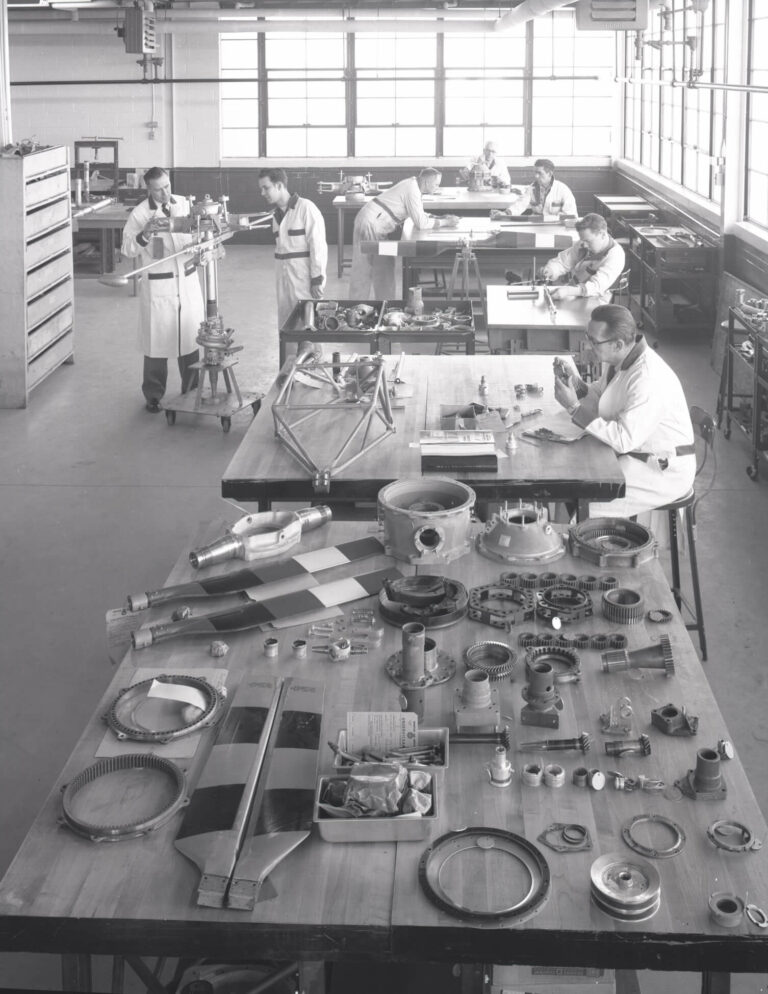
Hunter was a documentary photographer known for his industrial landscapes. He sold his first photograph as a teenager and developed expertise in images of industry and agriculture. In addition to his corporate work, he was employed as a press photographer during the Second World War. Between 1945 and 1950, he worked with the National Film Board of Canada’s Still Photography Division and completed several assignments in the North. He was appointed Canada’s official photographer to the United Nations in 1948. As a full-time freelancer, he became a pioneer in aerial photography, buying and modifying a small plane so he could photograph in flight.
Image: George Hunter, Ottawa—Plotting Air Photos at Spartan Air Service, 1957, black and white film negative, Canadian Heritage Photography Foundation, Mississauga. © Canadian Heritage Photography Foundation.
For further reading, see:
Hunter, George. “My Story.” Canadian Nature Photographer, May 27, 2012. https://www.canadiannaturephotographer.com/George_Hunter.html.
“The George Hunter Collection,” Canadian Heritage Photography Foundation, n.d. https://www.thechpf.com/the-george-hunter-collection.
Hunter, George, and Steve Cameron. George Hunter’s Canada: Iconic Images from Canada’s Most Prolific Photographer. Richmond Hill: Firefly Books, 2017.
Hunter, George, and Leslie Roberts. Canada in Colour. Toronto: Clarke, Irwin, 1959.

-
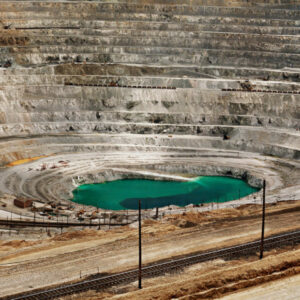 About the Authors
About the Authors
This book is written by art historians Sarah Bassnett and Sarah Parsons.
-
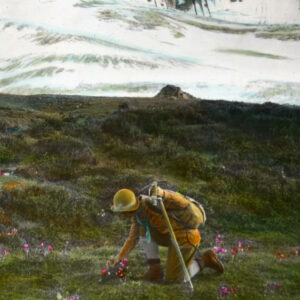 More Online Art Books
More Online Art Books
Read online or download the ACI’s incredible library of art books for free in French and English.
-
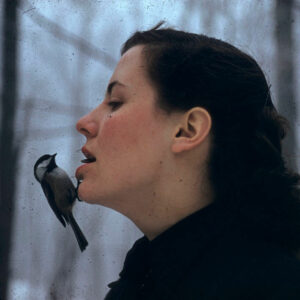 Preface
Preface
Photography has become so thoroughly integrated into our everyday experience that it may be hard to imagine life without it.
